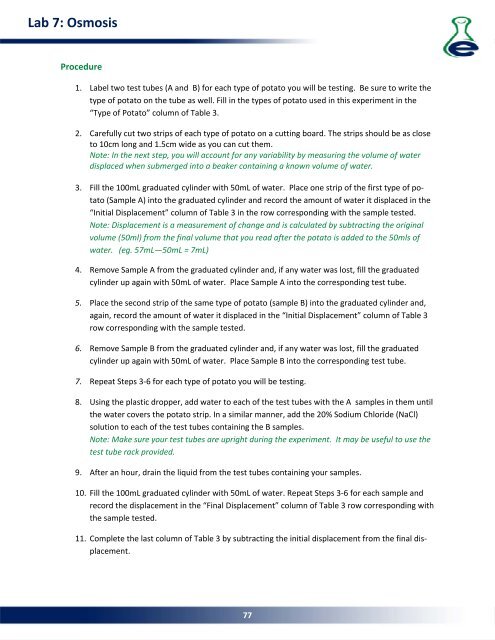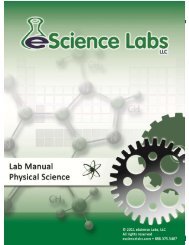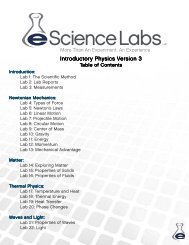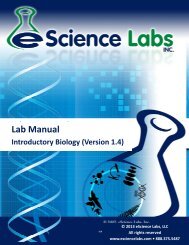Lab 15: Population Genetics - eScience Labs
Lab 15: Population Genetics - eScience Labs
Lab 15: Population Genetics - eScience Labs
Create successful ePaper yourself
Turn your PDF publications into a flip-book with our unique Google optimized e-Paper software.
<strong>Lab</strong> 7: Osmosis<br />
Procedure<br />
1. <strong>Lab</strong>el two test tubes (A and B) for each type of potato you will be testing. Be sure to write the<br />
type of potato on the tube as well. Fill in the types of potato used in this experiment in the<br />
“Type of Potato” column of Table 3.<br />
2. Carefully cut two strips of each type of potato on a cutting board. The strips should be as close<br />
to 10cm long and 1.5cm wide as you can cut them.<br />
Note: In the next step, you will account for any variability by measuring the volume of water<br />
displaced when submerged into a beaker containing a known volume of water.<br />
3. Fill the 100mL graduated cylinder with 50mL of water. Place one strip of the first type of potato<br />
(Sample A) into the graduated cylinder and record the amount of water it displaced in the<br />
“Initial Displacement” column of Table 3 in the row corresponding with the sample tested.<br />
Note: Displacement is a measurement of change and is calculated by subtracting the original<br />
volume (50ml) from the final volume that you read after the potato is added to the 50mls of<br />
water. (eg. 57mL—50mL = 7mL)<br />
4. Remove Sample A from the graduated cylinder and, if any water was lost, fill the graduated<br />
cylinder up again with 50mL of water. Place Sample A into the corresponding test tube.<br />
5. Place the second strip of the same type of potato (sample B) into the graduated cylinder and,<br />
again, record the amount of water it displaced in the “Initial Displacement” column of Table 3<br />
row corresponding with the sample tested.<br />
6. Remove Sample B from the graduated cylinder and, if any water was lost, fill the graduated<br />
cylinder up again with 50mL of water. Place Sample B into the corresponding test tube.<br />
7. Repeat Steps 3‐6 for each type of potato you will be testing.<br />
8. Using the plastic dropper, add water to each of the test tubes with the A samples in them until<br />
the water covers the potato strip. In a similar manner, add the 20% Sodium Chloride (NaCl)<br />
solution to each of the test tubes containing the B samples.<br />
Note: Make sure your test tubes are upright during the experiment. It may be useful to use the<br />
test tube rack provided.<br />
9. After an hour, drain the liquid from the test tubes containing your samples.<br />
10. Fill the 100mL graduated cylinder with 50mL of water. Repeat Steps 3‐6 for each sample and<br />
record the displacement in the “Final Displacement” column of Table 3 row corresponding with<br />
the sample tested.<br />
11. Complete the last column of Table 3 by subtracting the initial displacement from the final displacement.<br />
77
















